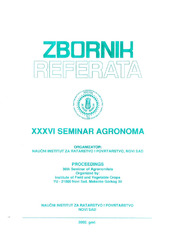Prikaz osnovnih podataka o dokumentu
Proizvodnja strnih žita u Jugoslaviji u 2000/01. i mere nege u tekućoj proizvodnji
Yugoslav small grains production in 2000/2001 and crop tending measures in current production
| dc.creator | Malešević, Miroslav | |
| dc.creator | Stamenković, Sreten | |
| dc.creator | Jevtić, Radivoje | |
| dc.creator | Bogdanović, Darinka | |
| dc.date.accessioned | 2024-03-15T09:50:08Z | |
| dc.date.available | 2024-03-15T09:50:08Z | |
| dc.date.issued | 2002 | |
| dc.identifier.uri | http://fiver.ifvcns.rs/handle/123456789/4371 | |
| dc.description.abstract | Ostvareni prinosi strnih žita u 2000/01. godini se mogu oceniti kao solidni s obzirom na veoma promenljive vremenske uslove. Ekstremi su se javljali kod padavina dok su temperature manje varirale u odnosu na prosečne vrednosti. Pored vremenskih uslova, ograničavajući faktori su bili pre svega nedostatak mineralnih đubriva. Iako je uvoz đubriva bio znatno olakšan, dugotrajno izostajanje naročito osnovnog đubrenja onemogućio je puni efekat prihranjivanja. Ova izrazita kišna perioda u aprilu i junu, direktnim i indirektnim efektima su uticali da prinos pšenice ne bude viši od 3,65 t/ha a ječma 3,21 t/ha . Jara žita su imala povoljnije uslove od ozimih u poređenju sa prethodnom godinom tehnološki kvalitet zrna pšenice je uglavnom bolji. Analiza rezultata egzaktnih ogleda će pokazati pravu veličinu ovogodišnjeg proizvodnog potencijala. To je jedan od ciljeva ovog rada. | sr |
| dc.description.abstract | In 2000/2001, a total of 691,000 ha of wheat was harvested and the yield was 3.65 t/ha. The average barley yield was 3.21 t/ha (132, 867 ha) and those of oats and rye 2.06 t/ha (6.2,205 ha) and 1.99 t/ha (5,895 ha), respectively. The 2000/2001 yields of small grains can be considered as fairly good, given the highly variable weather conditions. The grain yields in question were limited by a severe drought during the sowing season and abundant precipitation during April and June combined with the cultural practices applied. The key factors were late emergence, small winter moisture reserves, non-application of the basic NPK rate, and inadequate top dressing as well as the use of non-certified seed on more than 50% of the acreage. Powdery mildew occurred during the autumn and continued to develop into the spring of 2001. Other pathogens occurred only Sporadically. There was some token protection from diseases, although, when applied, the protection measures did have a significant effect. The weather conditions reduced the occurrence of small rodents and cereal beetles. The plant lice population was very sizeable, as was that of the cereal leaf beetle. Control measures were applied partially - on 6 and 18% of the area, respectively. | sr |
| dc.language.iso | sr | sr |
| dc.publisher | Novi Sad : Institut za ratarstvo i povrtarstvo | sr |
| dc.rights | openAccess | sr |
| dc.rights.uri | https://creativecommons.org/licenses/by/4.0/ | |
| dc.source | Zbornik referata, 36. Seminar agronoma, Zlatibor, januar 2002. | sr |
| dc.subject | prinos | sr |
| dc.subject | strna žita | sr |
| dc.subject | tehnologija gajenja | sr |
| dc.subject | yield | sr |
| dc.subject | small grains | sr |
| dc.subject | production technology | sr |
| dc.subject | crop protection | sr |
| dc.title | Proizvodnja strnih žita u Jugoslaviji u 2000/01. i mere nege u tekućoj proizvodnji | sr |
| dc.title | Yugoslav small grains production in 2000/2001 and crop tending measures in current production | sr |
| dc.type | conferenceObject | sr |
| dc.rights.license | BY | sr |
| dc.citation.epage | 174 | |
| dc.citation.spage | 163 | |
| dc.identifier.fulltext | http://fiver.ifvcns.rs/bitstream/id/9843/bitstream_9843.pdf | |
| dc.identifier.rcub | https://hdl.handle.net/21.15107/rcub_fiver_4371 | |
| dc.type.version | publishedVersion | sr |


